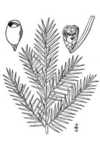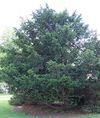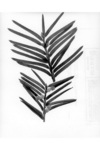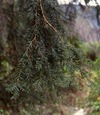Genus Taxus
Taxus is a genus of yews, small coniferous trees or shrubs in the yew family Taxaceae.Species in the genus Taxus of plants
Common Yew - It is a small- to medium-sized evergreen tree, growing 10–20 metres tall, with a trunk up to 2 metres diameter. The bark is thin, scaly brown, coming off in small flakes aligned with the stem. The leaves are lanceolate, flat, dark green, 1–4 centimetres long and 2–3 millimetres broad, arranged spirally on the stem, but with the leaf bases twisted to align the leaves in two flat rows either side of the stem, except on erect leading shoots where the spiral arrangement is more obvious. The leaves are highly poisonous.
Pacific yew - It is a small to medium-sized evergreen tree, growing 10–15 m tall and with a trunk up to 50 cm diameter, rarely more. In some instances, trees with heights in excess of 20m occur in parks and other protected areas, quite often in gullies. The tree is extremely slow growing, and has a habit of rotting from the inside, creating hollow forms. This makes it difficult to impossible to make accurate rings counts to determine a specimen's true age. Often damaged by succession of the forest, it usually ends up in a squat, multiple leader form.
Canada yew - Most of its range is well north of the Ohio River. It is, however, found as a rare ice age relict in some coves of the Appalachian Mountains. The southernmost colonies are known from Ashe and Watauga County, North Carolina.
Taxus chinensis - , a large, ornamental evergreen shrub or tree of the yew family , widespread in China at elevations up to 900 meters . The tree is up to 14 m tall and wide and bushy when cultivated. The leaves are up to 4 centimeters long—broader than those of most other yews—and often end in a very small, sharp point. The underside of each leaf has two broad yellow stripes and is densely covered with minute projections.
Japanese yew - It is an evergreen tree or large shrub growing to 10-18 m tall, with a trunk up to 60 cm diameter. The leaves are lanceolate, flat, dark green, 1-3 cm long and 2-3 mm broad, arranged spirally on the stem, but with the leaf bases twisted to align the leaves in two flattish rows either side of the stem except on erect leading shoots where the spiral arrangement is more obvious.
Florida yew - It is a evergreen coniferous shrub or small tree growing to 6 m tall, with a trunk up to 38 cm diameter. The bark is thin, scaly purple-brown, and the branches are spreading. The shoots are green at first, becoming brown after three or four years. The leaves are thin, flat, slightly falcate , 1–2.9 cm long and 1–2 mm broad, with a bluntly acute apex; they are arranged spirally on the shoots but twisted at the base to appear in two horizontal ranks on all except for erect lead shoots. It is dioecious, with the male and female cones on separate plants; the seed cone is highly modified, berry-like, with a single scale developing into a soft, juicy red aril 1 cm diameter, containing a single dark brown seed 5–6 mm long. The pollen cones are globose, 4 mm diameter, produced on the undersides of the shoots in early spring.
Taxus sumatrana - The Taxus sumatrana is a wide trunked, bushy tree that grows to an average height of 14 m. Its leaves are 1.2–2.7 cm long and 2–2.5 mm wide, and grow in two ranks along the branches, abruptly spiralling into an apex at the tip.
Himalayan yew - Taxus wallichiana is a species of yew, native to the Himalaya from Afghanistan east to western Yunnan in southwestern China, at altitudes from 2,000–3,500 m.






